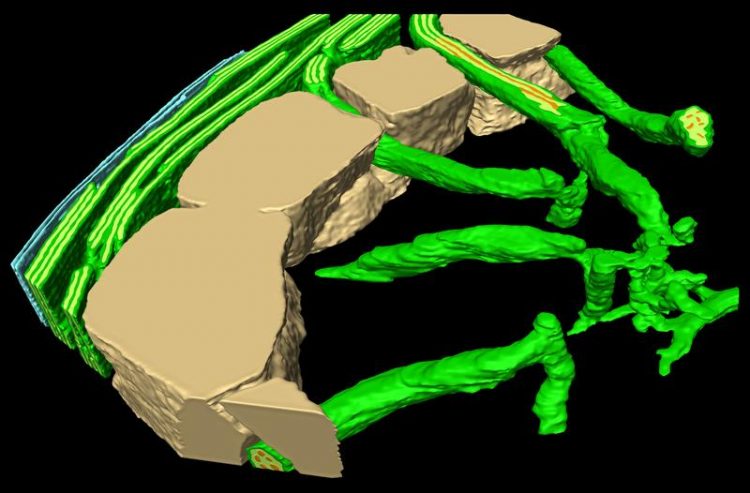Photosynthesis in 3D

3D cross section of a chloroplast of the alga Chlamydomonas. Small tubular structures connect the thylakoids (green stacks on the left) with the RuBisCO-containing pyrenoid (right). Figure: Ben Engel / Copyright: MPI of Biochemistry
“The results are the first of their kind and provide us with new insights into the mechanisms of photosynthesis”, says Benjamin Engel, first author of the study. The results were recently published in the journal eLife.
So far, researchers who wanted to observe tiny structures inside of cells had to use traditional electron microscopy. However, this method requires several preparation steps that damage cellular structures and limit the resolution and accuracy of the images. By using cryo-electron tomography, Wolfgang Baumeister and his team are able to avoid these steps by rapidly freezing the cells. Moreover, this allows them to visualize the internal architecture of cells in a close-to-living state. Using this technique, the scientists investigated the three dimensional structures of chloroplasts in the alga Chlamydomonas, shedding new light on their assembly and function.
Two spatially separated reactions take place during photosynthesis: while energy is harvested from sunlight in compartments called the thylakoids, carbon dioxide is fixed to form sugar molecules in a compartment called the pyrenoid. It was not understood how these processes could be coordinated. The new 3D images revealed the detailed structures of tubules that connect the pyrenoid with the thylakoids, providing conduits for the diffusion of energy molecules and sugars between these two separated parts of the chloroplast (see figure).
Besides the fact that there are connections between the two reaction compartments, the scientists were also able to show how the thylakoids receive new proteins and how the photosynthesis enzymes are organized: “In the pyrenoid, there are many units of the photosynthesis enzyme RuBisCO”, explains Benjamin Engel, scientist at the MPI of Biochemistry. “Our results show for the first time that these units are packed in a hexagonal arrangement.” In the future, the authors aim to elucidate how this RuBisCO organization is formed and whether more proteins are involved. [HS]
Original publication:
Engel B, Schaffer M, Kuhn Cuellar L, Villa E, Plitzko JM and Baumeister W: Native Architecture of the Chlamydomonas Chloroplast Revealed by In Situ Cryo-Electron Tomography. eLife, January 13, 2015.
DOI: 10.7554/eLife.04889
Contact:
Prof. Dr. Wolfgang Baumeister
Molecular Structural Biology
Max Planck Institute of Biochemistry
Am Klopferspitz 18
82152 Martinsried
Germany
E-Mail: baumeist@biochem.mpg.de
http://www.biochem.mpg.de/baumeister
Anja Konschak
Public Relations
Max Planck Institute of Biochemistry
Am Klopferspitz 18
82152 Martinsried
Germany
Phone: +49 89 8578-2824
E-Mail: konschak@biochem.mpg.de
http://www.biochem.mpg.de
http://www.biochem.mpg.de/baumeister – Website of the Research Department “Molecular Structural Biology” (Prof. Dr. Wolfgang Baumeister)
http://www.biochem.mpg.de/news – More press releases of the MPI of Biochemistry
Media Contact
All latest news from the category: Life Sciences and Chemistry
Articles and reports from the Life Sciences and chemistry area deal with applied and basic research into modern biology, chemistry and human medicine.
Valuable information can be found on a range of life sciences fields including bacteriology, biochemistry, bionics, bioinformatics, biophysics, biotechnology, genetics, geobotany, human biology, marine biology, microbiology, molecular biology, cellular biology, zoology, bioinorganic chemistry, microchemistry and environmental chemistry.
Newest articles

Silicon Carbide Innovation Alliance to drive industrial-scale semiconductor work
Known for its ability to withstand extreme environments and high voltages, silicon carbide (SiC) is a semiconducting material made up of silicon and carbon atoms arranged into crystals that is…

New SPECT/CT technique shows impressive biomarker identification
…offers increased access for prostate cancer patients. A novel SPECT/CT acquisition method can accurately detect radiopharmaceutical biodistribution in a convenient manner for prostate cancer patients, opening the door for more…

How 3D printers can give robots a soft touch
Soft skin coverings and touch sensors have emerged as a promising feature for robots that are both safer and more intuitive for human interaction, but they are expensive and difficult…





















